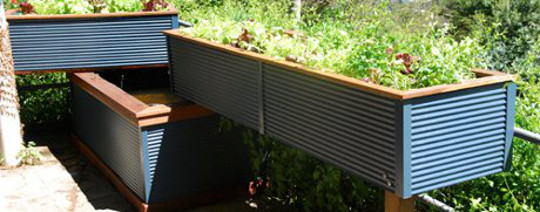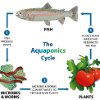
The Aquaponics Epiphany: Growing Fish & Vegetables in the Basement!
The rain was a gift. I had set aside that entire Saturday in early April to do yard work, but instead was searching for something to do inside. As it happened, my then 14-year-old son also had no plans, and my husband and daughter were out of town. Hmmm. What to do? Clearly something together would be best, but where was the overlap in our current interests?
I remembered my longtime buddy at AeroGrow, John, had been for trying for months to get me to come over to see his basement aquaponic system. Fish and crawdads growing plants in a basement might be interesting. The added bonus of seeing their new baby chicks sealed the deal. We got in the car and drove off without realizing that our lives were about to be changed forever.
Aquaponics: No More Weeds, Watering, Fertilizing or Back Strain
When my son and I walked into the basement of John's rural ranch house, we were greeted with the sounds of baby chicks scratching on their newspaper-lined flooring and water flowing among the grow beds. The room was well lit and warm from the plant growing lights. The air smelled moist and fresh. The plants I saw were healthy and huge and the fish were active and obviously hungry as John tossed in a handful of food. He was excited to show us his setup and to debunk my skepticism.
Get The Latest By Email
When I saw that basement setup, I was immediately convinced that aquaponics was going to become a very important growing technology. I concluded that it solves the problem of expensive, and often unsafe, chemical fertilizers in hydroponics. It solves the problem of waste removal in aquaculture. It solves the problem of excess water use in traditional agriculture. And for the backyard gardener, it solves the problems of weeds, under- and over-watering, fertilizing and back strain.
The Aquaponics Community: Shared Learning & Support
Since that rainy April day, I've dedicated my life to learning all I can about aquaponics and spreading the word about this amazing way to grow plants. In December 2009, I started the Aquaponic Gardening Blog to write about my personal journey through aquaponics. Topics have ranged from practical advice on seed starting and grow bed depth to musings about organic certification and visits with fellow aquaponic addicts.
In January 2010, I started the Aquaponic Gardening Community site. It has become a thriving meeting place for worldwide, round-the-clock conversations about aquaponics. This community, and other aquaponics communities and forum sites around the world, are an incredible source of shared learning and support for this burgeoning new growing technique and industry.
Home-Scale Aquaponics: DIY Fish Tank Gardening
 Home-scale aquaponic gardeners have evolved from the early tinkerers setting up systems in their backyards and basements. They learned from the academic work that was going on in North Carolina and the Virgin Islands, and then focused on making systems that were simpler and cheaper to build and operate. They wanted systems that could grow a wide variety of crops, not just salad greens and tilapia. They wanted to use recycled materials and off-the-shelf parts. They wanted the least amount of monitoring and fuss possible.
Home-scale aquaponic gardeners have evolved from the early tinkerers setting up systems in their backyards and basements. They learned from the academic work that was going on in North Carolina and the Virgin Islands, and then focused on making systems that were simpler and cheaper to build and operate. They wanted systems that could grow a wide variety of crops, not just salad greens and tilapia. They wanted to use recycled materials and off-the-shelf parts. They wanted the least amount of monitoring and fuss possible.
Probably one of the earliest examples was in West Plains, Missouri, in the early 1990s. Tom and Paula Speraneo created a successful media-based aquaponics farm called S&S AquaFarm and subsequently wrote a guide for others to follow what they had learned.
Gardening Aquaponically: The Solution for Water Shortage, Floods, and Sore Backs
In the early 2000's Joel Malcom, an engineer from Perth, Australia started experimenting with his own backyard system, wrote a book about his experience called Backyard Aquaponics, and founded a company by the same name. Now Joel also runs the world's largest aquaponics forum site and is the publisher of Backyard Aquaponics Magazine, in addition to his very successful aquaponics systems and supplies business.
At the same time that Joel started his aquaponics adventure, fellow Australian Murray Hallam heard about aquaponics. Although Murray also had an aquaponic system business on the other side of the country, the two men collaborated and learned from each other. Murray's company, Practical Aquaponics, also sells aquaponic systems and supplies and he also runs a large forum site. Murray is now probably best known worldwide for his entertaining educational Aquaponic video series.
Australia has been experiencing one of their worst droughts in recorded history so the water-conserving benefit of aquaponics is especially appealing there. Finally, in the recent devastating floods in Queensland, aquaponics again proved to be uniquely adapted to Australia. While grocery store produce aisles were picked over, aquaponic gardeners were picking fresh veggies from their raised grow beds.
Media-Based Aquaponics vs. Raft and NFT Systems
In a media-based system the grow bed becomes the filtration system for all the waste products. If a media system is constructed, stocked and operated as instructed in my book, Aquaponic Gardening, the only solids removal that will need to be done will be a monthly shot of high-pressure water through your pipes and pump to knock lose any solid waste buildup inside. Otherwise there is no regular clean-out of the grow beds or fish tanks. Ever.
The second reason why media systems are more appropriate for home gardening is that there is almost no limit to the types of plants you can grow in these systems. Raft and NFT systems have lower levels of nutrients because of the solids removal and they pose logistical constraints around a set of holes arranged on a fixed grid on a floating raft. These both conspire to limit the types of plants that grow best to smaller, nitrogen-loving plants like salad greens and herbs.
Grow Absolutely Anything That Doesn't Require an Acidic Soil
In contrast, a media-based system can grow absolutely anything that doesn't require an acidic soil (blueberries, for example, don't do well in any aquaponic system). I know a woman in Florida who has grown a banana tree. Murray Hallam has grown papaya trees.
I have grown 25-foot tomato plants, ground cherries, peppers, cucumbers, strawberries, celery, broccoli ... as well as salad greens and herbs. Backyard gardeners do not want to be limited in what they can grow.
©2011 by Sylvia Bernstein. All rights reserved.
Reprinted with permission of the publisher,
New Society Publishers. http://newsociety.com
This article was adapted with permission from the book:
Aquaponic Gardening: A Step-By-Step Guide to Raising Vegetables and Fish Together
by Sylvia Bernstein.
 A combination of aquaculture and hydroponics, aquaponic gardening is an amazingly productive way to grow organic vegetables, greens, herbs, and fruits, while providing the added benefits of fresh fish as a safe, healthy source of protein. Aquaponic Gardening is the definitive do-it-yourself home manual, focused on giving you all the tools you need to create your own aquaponic system and enjoy healthy, safe, fresh, and delicious food all year round.
A combination of aquaculture and hydroponics, aquaponic gardening is an amazingly productive way to grow organic vegetables, greens, herbs, and fruits, while providing the added benefits of fresh fish as a safe, healthy source of protein. Aquaponic Gardening is the definitive do-it-yourself home manual, focused on giving you all the tools you need to create your own aquaponic system and enjoy healthy, safe, fresh, and delicious food all year round.
Click here for more info and/or to order this book.
About the Author
 Sylvia Bernstein is the president and founder of The Aquaponic Source and the Chairman of the U.S. Chapter of the Aquaponics Association. She also manages AquaponicsCommunity.com, the largest US-based online community site dedicated to aquaponic gardening. An experienced speaker and internationally recognized expert on aquaponic gardening, Sylvia writes and blogs on the subject for the Aquaponic Gardening Blog, Growing Edge and more. Her inspiration is a large, thriving aquaponic setup in her backyard greenhouse in Boulder, CO powered by tilapia, catfish, and other creatures-that-swim.
Sylvia Bernstein is the president and founder of The Aquaponic Source and the Chairman of the U.S. Chapter of the Aquaponics Association. She also manages AquaponicsCommunity.com, the largest US-based online community site dedicated to aquaponic gardening. An experienced speaker and internationally recognized expert on aquaponic gardening, Sylvia writes and blogs on the subject for the Aquaponic Gardening Blog, Growing Edge and more. Her inspiration is a large, thriving aquaponic setup in her backyard greenhouse in Boulder, CO powered by tilapia, catfish, and other creatures-that-swim.








